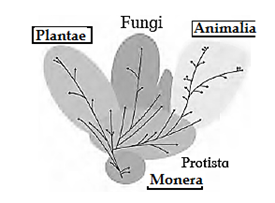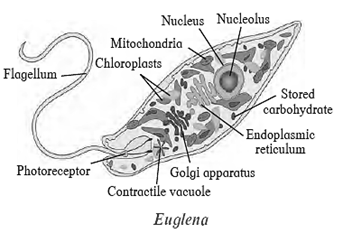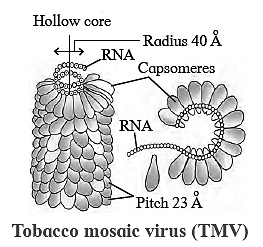Question 1.
Choose correct option
A. Which of the following shows single stranded RNA and lacks protein coat?
a. Bacteriophage
b. Plant virus
c. Viroid
d. Animal virus
B. Causative agent of red tide is _____________.
a. Dinoflagellate
b. Euglenoid
c. Chrysophyte
d. Lichen
C.Select odd one out for Heterotrophic bacteria.
a. Nitrogen fixing bacteria
b. Lactobacilli
c. Methanogens
d. Cyanobacteria
D.Paramoecium : Ciliated Protist Plasmodium : ____________
a. Amoeboid protozoan
b. Ciliophora
c. Flagellate protozoan
d. Sporozoan
Question 2.
Answer the following
A. What are the salient features of monera?
Answer :
Salient features of Kingdom Monera: ‘
Size: The organisms included in this kingdom are microscopic, unicellular and prokaryotic.
Occurrence: These are omnipresent. They are found in all types of environment which are not generally inhabited by other living beings.
Nucleus: These organisms do not have well defined nucleus. DNA exists as a simple double stranded circular single chromosome called as nucleoid. Apart from the nucleoid they often show presence of extra chromosomal DNA which is small circular called plasmids.
Cell wall: Cell wall is made up of peptidoglycan (also called murein) which is a polymer of sugars and amino acids.
Membrane bound cell organelles: Membrane bound cell organelles like mitochondria, chloroplast, endoplasmic reticulum are absent. Ribosomes are present, which are smaller in size (70S) than in eukaryotic cells.
Nutrition: Majority are heterotrophic, parasitic or saprophytic in nutrition. Few are autotrophic that can be either photoautotrophs or chemoautotrophs.
Reproduction: The mode of reproduction is asexual or with the help of binary fission or budding. Very rarely, sexual reproduction occurs by conjugation method.
Examples:
Archaebacteria: e.g. Methanobacillus, Thiobacillus, etc.
Eubacteria: e. g. Chlorobium, Chromatium,
Cyanobacteria e.g. Nostoc, Azotobacter, etc.
B. What will be the shape of bacillus and coccus type of bacteria?
Answer :
The shape of bacillus type of bacteria is rod-shaped and coccus is spherical
C. Why is binomial nomenclature important?
Answer :
Importance of Binomial nomenclature :
- The binomials are simple, meaningful and precise. .
- They are standard since they do not change from place to place.
- These names avoid confusion and uncertainty created by local or vernacular names
- The organisms are known by the same name throughout the world.
- The binomials are easy to understand and remember due to the rhyming.
- It indicates phylogeny (evolutionary history) of organisms.
- It helps to understand inter-relationship between organisms.
Question 3.
Write short notes
A. Useful and harmful bacteria.
Answer :
Useful bacteria:
Most of the bacteria act as a decomposer. They breakdown large molecules in simple molecules or minerals.
Examples of some useful bacteria:
- Some bacteria helps in curdling of milk. Example- Lactobacillus.
- Helps to fix nitrogen for plants. Example- Azotobacter.
- Some bacteria like Streptomyces is used in antibiotic production such as streptomycin.
- Methanogens: These are used for production of methane (biogas) gas from dung.
- Pseudomonas spp. and Alcanovorax borkumensis: These bacteria have the ability to destroy the pyridines and other chemicals. Hence, used to clear the oil spills.
Harmful bacteria:
This includes disease causing bacteria. They cause various diseases like typhoid, cholera, tuberculosis, tetanus, etc.
Examples of some harmful bacteria:
- Salmonella typhi: It is a causative organism of typhoid.
- Vibrio cholera : It causes cholera.
- Mycobacterium tuberculosis: It causes tuberculosis.
- Clostridium tetani: It causes tetanus.
- Clostridium spp.: It causes food poisoning.
- Many forms of mycoplasma are pathogenic.
B. Five Kingdom system
Answer :
Five kingdom system of classification : Five kingdom system of classification was proposed by R.H. Whittaker. This system shows the phylogenetic relationship between the organisms.
The five kingdoms are:
- Kingdom Monera : The organisms included in this kingdom are microscopic, unicellular and prokaryotic. Example : Archaebacteria, Eubacteria, Cyanobacteria
- Kingdom Protista : Unicellular eukaryotic organisms are included in kingdom Protista. Kingdom Protista shows link with all eukaryotic kingdoms such as kingdom plantae, fungi and Animalia
- Kingdom Plantae : Kingdom plantae is dominated by autotrophs. It also includes some semiautotrophic members, the insectivorous plants like Venus fly trap, pitcher plant, bladderwort, as well as heterotrophic parasitic members like Cuscuta.
- Kingdom Fungi : It is a unique kingdom of eukaryotic heterotrophic organisms, showing extracellular digestion. They may be unicellular or multicellular and filamentous. These are commonly found in warm and humid places.
- Kingdom Animalia : The organisms are multicellular and eukaryotic.
C. Useful Fungi
Answer :
Uses of fungi in various sectors :
Use of fungi in medicine:
- Antibiotic penicillin is obtained from Penicillium.
- Drugs like cyclosporine, immunosuppressant drugs, precursors of steroid hormones, etc. are isolated from fungi.
Use of fungi in industries:
- Yeast is used in bread making. It causes dough to rise and make the bread light and spongy. It is also used in breweries or wine making industries. Sugars present in grapes are fermented by using yeast. This results in production of alcohol which is used for making wine.
- Lichen is a symbiotic association of algae and fungi are used in preparation of litmus paper which is used as acid-base indicator.
Use of fungi in food:
- Fungi like mushrooms are consumed as a food. These are rich source of protein.
- Fungi genus Penicillium helps in ripening of cheese.
Use of fungi as biocontrol agents:
- Fungi helps to control growth of weeds. -
- Pathogenic fungi like Fusarium sp., Phytophthora palmivora, Alternaria crassa, etc. act as mycoherbicides.
Question 4.
Complete tree diagram in detail
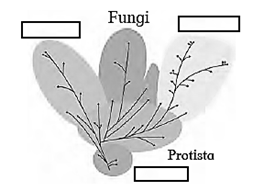
Question 5.
Draw neat labelled diagrams
A. Paramoecium
B. Euglena
C. TMV
Question 6.
Complete chart and explain in your word
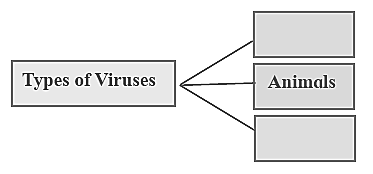
Answer :
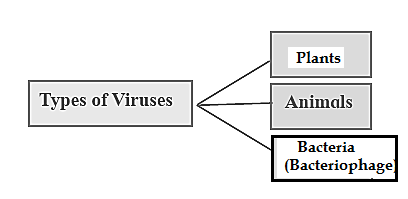
Types of viruses :
Depending upon the host, viruses are classified into three types as:
- Plant virus
- Animal virus
- Bacterial virus (Bacteriophage)
Plant virus:
- Generally, they are rod shaped or cylindrical with helical symmetry.
- Majority of plant viruses have RNA as their genetic material. (Exception: Cauliflower Mosaic Virus has double stranded DNA as genetic material)
- Plant viruses cause disease in plants. e.g. Tobacco Mosaic Virus (TMV).
Animal virus:
- Generally, they are polyhedral in shape with radial symmetry.
- They have either DNA or RNA as genetic material.
- It causes disease to majority of animals including human beings. e. g. Influenza virus.
Bacteriophage:
- They have tadpole-like shape.
- They infect bacteria and hence are called as bacteriophage.
- C. Bacteriophages were discovered by Twort.
- Bacteriophages have double stranded DNA as the genetic material.
- Its body consists of head, collar and tail.
Question 7.
Identify the following diagrams, label them and write detail information in your words.
A:
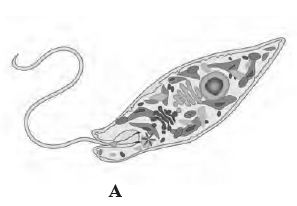
Answer :
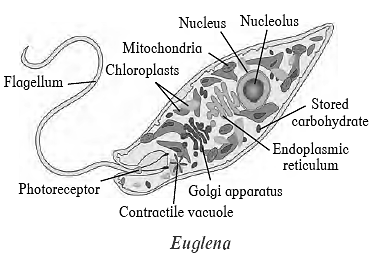
It belongs to kingdom Protista. It is further classified into euglenoids:
- They lack cell wall but have a tough covering of proteinaceous pellicle.
- Pellicle covering provides flexibility and contractibility to Euglena.
- They possess two flagella, one short and other long.
- They behave as heterotrophs in absence of light but possess pigments, similar to that of higher plants, for photosynthesis
B:

Answer :
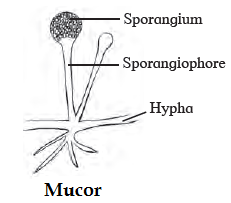
The given figure represents Mucor.
Characteristics:
- It belongs to class phycomycetes of kingdom fungi.
- Mycelium is made up of aseptate coenocytic hyphae.
- It commonly grows on decaying fruits, vegetables, in soil, on various food- stuff-like bread, jellies, jams, etc. A
- In favourable conditions mucor reproduces asexually by formation of spores within sporangia. It can also reproduce by sexual means.
C:
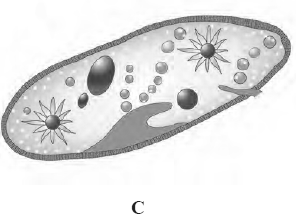
Answer :
This figure represents Paramoecium
Characteristiscs:
- It belongs to kingdom Protista. It is further classified as animal like protist
- It lacks cell wall.
- It shows heterotrophic and holozoic nutrition.
- It is a ciliated protozoan where locomotion is due to cilia.
- It has gullet (a cavity) which opens on the cell surface.
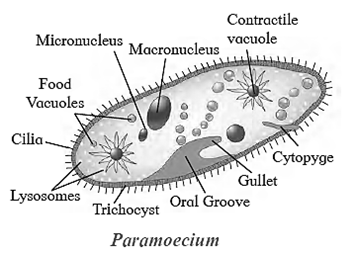
D:
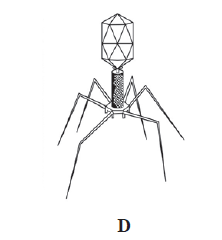
Answer :
This figure represents Bacteriophage
Bacteriophage:
- They have tadpole-like shape.
- They infect bacteria and hence are called as bacteriophage.
- C. Bacteriophages were discovered by Twort.
- Bacteriophages have double stranded DNA as the genetic material.
- Its body consists of head, collar and tail.

E:

Answer :
The given figure represents Aspergillus.
Characteristics:
- It belongs to class ascomycetes of kingdom Fungi.
- It is multicellular.
- The hyphae are branched and septate.
- Aspergillus grows well in soil, decaying vegetation, hay, dung, on plants, etc.
- Asexual reproduction takes place by spores called conidia which are produced at the tip of hyphae called conidiophores.

F :

Answer :
The given figure represents Agaricus (Mushroom).

Characteristics:
- It belongs to class basidiomycetes of kingdom Fungi.
- It has branched septate hyphae.
- It grows in soil, on rotten wood, etc.
- It is edible and rich in proteins.
- Vegetative reproduction takes place by fragmentation.
Question 8.
The scientific name of sunflower is given below. Identify the correctly written name.
- Helianthus annuus L.
- Helianthus Annuus l.
Question 9.
Match the following.
| Kingdom |
Example |
| i. Monera
ii. Protista
iii. Plantae
iv. Fungi
|
a. Riccia
b. Cyanobacteria
c. Rhizopus
d. Diatoms
|
Answer :
| Kingdom |
Example |
| i. Monera
ii. Protista
iii. Plantae
iv. Fungi
|
b. Cyanobacteria
d. Diatoms
a. Riccia
c. Rhizopus
|
Question 10.
Complete the following
- Plant-like Protista - …………………
- ………………… Entamoeba
Answer :
- Plant-like Protista - Diatoms
- Animal-like Protista - Entamoeba
Practical / Project :
Find out types of lichens and its economic importance.
Answer :
Types of lichens are:
Based on fungal components:
- Ascolichens: In this category, the fungal partner belongs to Ascomycetes group of fungi.
- Basidiolichens: Here, the fungal partner belongs to Basidiomycetes group of fungi.
- Deuterolichens: In this category, the fungal partner belongs to Deuteromycetes group of fungi.
Based on their forms: -
- Crustose lichen: These lichens show crust-like growth. These lichens grow on rocks and bark of the trees. e.g. Graphis, Lecanora, Haematomma, etc.
- Foliose lichen: These lichens grow on trees in the hilly regions. The thallus is like a dry forked leaf. e.g. Parmelia, Collema, Peltigera.
- Fruticose lichen: These lichens are seen on the branches of trees hanging down.
- They are cylindrical, well branched and pendulous, with hair-like outgrowths e.g. Usnea, Cladonza, Alectorza, etc.
Economic importance of lichens:
Lichen as food and fodder:
- Many species of lichens are used as food by animals including man. Lichens contain a substance lichenin which is similar to carbohydrate making them edible.
- Parmelia is used in curry powder in India. Lichens like Cladonia, Citraria, Evernia, Parmelia are used as fodder as they form a favourite food for reindeers and cattles.
Lichens in medicine:
- Lichens contain usnic acid due to which they are used in medicines. Usnea and Cladonia species are used as an antibiotic against Gram positive bacteria.
- Species like Lobaria, Citraria are useful in respiratory disease like T.B., Peltigera is useful in hydrophobia, Parmelia is used in treatment of epilepsy, whereas Usnea is used in urinary disease.
- Some lichens are also used in medicine due to their anticarcinogenic property.
Industrial use of lichens:
- Lichens are used in various dyes for colouring fabrics.
- Species like Rocella and Lasallia are used in preparation of litmus paper which is acid-base indicator.
- In Sweden and Russia, lichens are used for production of alcohol.
- Orcein is a biological stain obtained from Orchrolechia androgyna and O tortaria.
- Some lichens are also used in tanning process in leather industry.
- Evernia and Ramalina are the sources of essential oils which are used in preparation of soaps and other cosmetics.
Other uses of lichens:
- Lichens are used in cosmetics.
- Some lichens like Evernia prunastri also known as oakmoss is used in making perfumes.
- Lichen is also used as a preservative for beer.

